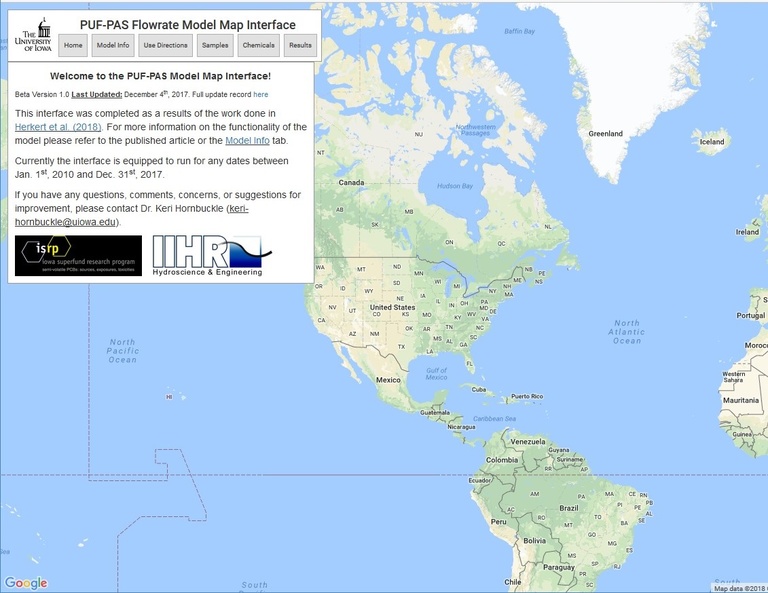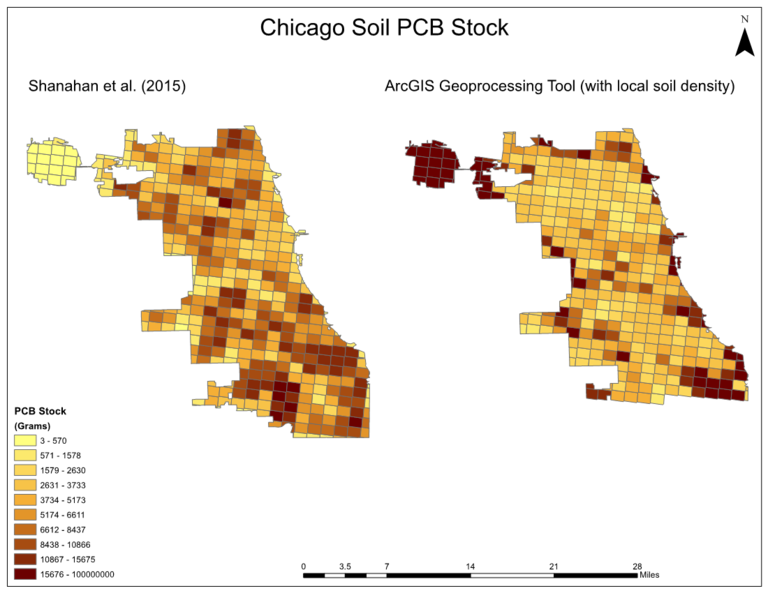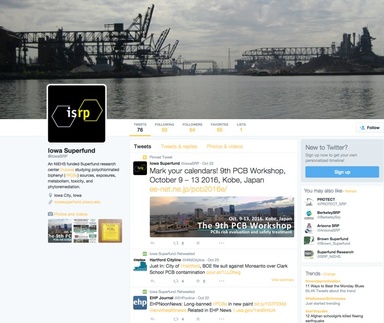Breadcrumb
Research Translation Core
The activities accomplished and proposed by the Research Translation Core (RTC), more than any other part of the Iowa Superfund Research Program (ISRP), endeavor to connect research projects to the world. It has four aims:
1. Communicate within the Superfund Research Program and to academic and research colleagues internationally, nationally and locally.

The RTC worked with Project 4 and the Analytical Core to refine the PUF-PAS modeling web application and develop a long-term plan for supporting the application, including routine updating of meteorological input data from the NASA Modern-Era Retrospective analysis for Research and Applications (MERRA-2). The Global Atmospheric Passive Sampling (GAPS) network applied the model operationally for all 2018 deployments.
The RTC’s @iowasrp Twitter account continued to share isrp publications, findings, events, data, photos, videos, and narratives. Posts and discussions on isrp research and new publications from all projects and cores, the PCB Workshop, Superfund PCB remediation, federal CRCLA and TSCA updates, and PCB/SVOC/POPs research and policy news worldwide have led to enhanced sharing of results with other SRPs, interviews and press for isrp researchers, and greater reach.
2. Partner with government agencies to facilitate the development of sound public policies and practices.
The RTC shared geolocated transformer data and PCB stock estimates from the US EPA PCB transformer registration database with the Lake Superior Lakewide Action and Management Plan (LAMP) Coordinator, Minnesota Pollution Control Agency, and Environment and Climate Change Canada. It also worked with the LAMP Coordinator to refine stock and emissions models for use with a range of in-service transformer datasets, survey responses, and metadata reported by public utilities in Minnesota, Wisconsin, and Michigan.
In 2019, the RTC is partnering to develop a refined transformer inventory for the Lake Superior watershed to inform plan implementation, accompanied by parcel-scale area source estimates for the watershed’s five largest urban areas generated with the PCB source app. Shared inventory data for was included in a report led by University of Toronto researchers presented at SETAC North America. A global country-level analysis of closed source PCB stocks and progress toward close source PCB management is in preparation for publication in 2019.
Co-PI Just initiated contact with the School Superintendents Association (AASA), who shared results of their recent survey of PCBs in buildings and discussed decision support needs.
PI Spak and trainees Mai and Islam continued development of a second application that will allow government agencies to comprehensively estimate congener-specific PCB stocks and emissions rates at parcel and building scale from all quantifiable sources with user-provided spatial data. In 2018, the RTC implemented an ArcMap and ArcPy model that automates geoprocessing and congener speciation of area source (paint, caulk, sealant, soil) and transformer stocks and emissions and compared results to prior estimates for Chicago and Seattle. It refined inventory closed source and transformer database quality control process and pure PCB stock calculations with MNPCA and ECCC. A major enhancement to area source calculations was the addition of local variability in soil density from the high resolution NRCS Gridded Soil Survey Geographic (gSSURGO) Database, which alters the intra-urban spatial distribution of PCBs from pervious soils.

The model is fully functional and accessible for use by local government: stocks and emissions calculations, gridding, and automated mapping and analysis for a city the size of Chicago complete in 2-3 hours on a desktop PC using one configuration form, followed by manual additions for landfills, contaminated waterways, wastewater treatment plants, and other point sources. In 2019, the RTC is porting the system to ArcGIS Pro, testing it in open beta, and preparing a publication describing the refined modeling system and inter-urban variability in area source PCB emissions estimates.
Professor Lucie Laurian (Urban & Regional Planning) is developing interview and survey instruments for evaluating the impact of SRP RTC and CEC activities on public policies and practices. In 2018, Laurian developed instruments and protocols for gathering and analyzing data, and tested them in phone interviews with journalists covering a school remediation story without SRP involvement. Upon completing pilot testing, the RTC will apply the instruments to assess ISRP contributions in East Chicago.
3. Formally transfer technology to commercial enterprises able to develop and deliver products or services to the public.
The RTC continues to explore opportunities to license ISRP technologies, identify additional bioremediation study opportunities with EcoloTree, and include additional commercial enterprises in research.
4. Contribute to a broader public understanding of problems and solutions regarding environmental hazards and their remediation through information dissemination to other end users.

In 2018, the RTC’s @iowasrp Twitter account continued as the world’s leading source for PCB science, hazards, policy, and remediation news, with 72K unique impressions. In 2018, we instituted routine weekly, monthly, and annual social media tracking and evaluation routines using Twitter Analytics, Hootsuite, Kred, and Union Metrics.
Scott Spak, Core Leader
Dr. Spak, Associate Professor, Urban and Regional Planning, is responsible for supervising all aspects of research translation, including monitoring the development of new innovations and applications that arise as a result of isrp research, facilitating the exchange of information and resources to isrp stakeholders, identifying potential partners in industry and government, and continuing to grow, evaluate, and strengthen the isrp social media program. Dr. Spak is also directly involved in the planning of all Core activities and has specific responsibility for liaison work with governmental partners, including local, state, regional and national representatives, Region VII, EPA and others.
Craig Just
Dr. Just, Associate Professor, Civil and Environmental Engineering, The University of Iowa, has a broad and long-standing experience in engagement. He guided the development of the Public Engagement Grant Program that commenced at the University of Iowa in 2011. His commitment to engagement was acknowledged in 2010 with the David Skorton Award for Staff Excellence in Public Service. He co-directs the UI Obermann Graduate Institute on Engagement and the Academy.